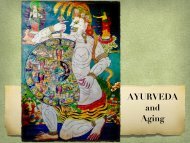How Thoreau's Walden Pond Mixed with the Ganges and Yoga Came to America with Swami Vivekananda
One early morning in 1846, during the coldest days of a New England winter, Henry David Thoreau looked out the window of his small cabin on Walden Pond and saw men cutting its ice into blocks. That ice was hauled by horse to a railroad that ran across the western edge of Walden Pond, packed into a boxcar, taken to Boston and loaded onto a clipper ship that sailed to Calcutta, India, arriving about four months later. Once there, that ice was purchased by grateful members of the East India Company. Thoreau had witnessed a small part of the global ice trade between New England and India that took place during the latter part of the nineteenth century. When Thoreau considered the ice trade, his vision sailed on metaphors far beyond the scope of business. The waters he imagined flowed both east and west and carried not just natural elements, but culture, religion and philosophy as well. He envisioned that after arriving in Calcutta, the New England ice of Walden Pond would eventually melt and run downhill where it would join with the sacred water of the Ganges. He wrote in Walden: "It appears that the sweltering inhabitants of Charleston and New Orleans, of Madras and Bombay and , drink at my well. In the morning I bathe my intellect in the stupendous and cosmogonal philosophy of the , since whose composition years of the gods have elapsed, and in comparison with which our modern world and its literature seem puny and trivial; and I doubt if that philosophy is not to be referred to a previous state of existence, so remote is its sublimity from our conceptions. I lay down the book [Bhagavad-Gita] and go to my well for water, and lo! there I meet the servant of the Bramin, priest of and and who still sits in his temple on the Ganges reading the , or dwells at the root of a tree with his crust and water jug. I meet his servant come to draw water for his master, and our buckets as it were grate together in the same well. The pure Walden water is mingled with the sacred water of the Ganges." This book tells the story of these waters . . .
One early morning in 1846, during the coldest days of a New England winter, Henry David Thoreau looked out the window of his small cabin on Walden Pond and saw men cutting its ice into blocks. That ice was hauled by horse to a railroad that ran across the western edge of Walden Pond, packed into a boxcar, taken to Boston and loaded onto a clipper ship that sailed to Calcutta, India, arriving about four months later. Once there, that ice was purchased by grateful members of the East India Company. Thoreau had witnessed a small part of the global ice trade between New England and India that took place during the latter part of the nineteenth century.
When Thoreau considered the ice trade, his vision sailed on metaphors far beyond the scope of business. The waters he imagined flowed both east and west and carried not just natural elements, but culture, religion and philosophy as well. He envisioned that after arriving in Calcutta, the New England ice of Walden Pond would eventually melt and run downhill where it would join with the sacred water of the Ganges. He wrote in Walden: "It appears that the sweltering inhabitants of Charleston and New Orleans, of Madras and Bombay and , drink at my well. In the morning I bathe my intellect in the stupendous and cosmogonal philosophy of the , since whose composition years of the gods have elapsed, and in comparison with which our modern world and its literature seem puny and trivial; and I doubt if that philosophy is not to be referred to a previous state of existence, so remote is its sublimity from our conceptions.
I lay down the book [Bhagavad-Gita] and go to my well for water, and lo! there I meet the servant of the Bramin, priest of and and who still sits in his temple on the Ganges reading the , or dwells at the root of a tree with his crust and water jug. I meet his servant come to draw water for his master, and our buckets as it were grate together in the same well. The pure Walden water is mingled with the sacred water of the Ganges."
This book tells the story of these waters . . .
You also want an ePaper? Increase the reach of your titles
YUMPU automatically turns print PDFs into web optimized ePapers that Google loves.
Oracle at Delphi<br />
“Delphi is perhaps best known for <strong>the</strong> oracle at <strong>the</strong> sanctuary that was dedicated<br />
<strong>to</strong> Apollo during <strong>the</strong> classical period. According <strong>to</strong> Aeschylus in <strong>the</strong> prologue of<br />
<strong>the</strong> Eumenides, it had origins in prehis<strong>to</strong>ric times <strong>and</strong> <strong>the</strong> worship of Gaia. In<br />
<strong>the</strong> last quarter of <strong>the</strong> 8th century BC <strong>the</strong>re is a steady increase in artifacts found<br />
at <strong>the</strong> settlement site in Delphi, which was a new, post-Mycenaean settlement of<br />
<strong>the</strong> late 9th century. Pottery <strong>and</strong> bronze work as well as tripod dedications continue<br />
in a steady stream, in comparison <strong>to</strong> Olympia. Nei<strong>the</strong>r <strong>the</strong> range of objects<br />
nor <strong>the</strong> presence of prestigious dedications proves that Delphi was a focus of attention<br />
for a wide range of worshippers, but <strong>the</strong> large quantity of high value<br />
goods, found in no o<strong>the</strong>r mainl<strong>and</strong> sanctuary, certainly encourages that view.<br />
Apollo spoke through his oracle: <strong>the</strong> sibyl or priestess of <strong>the</strong> oracle at Delphi<br />
was known as <strong>the</strong> Pythia; she had <strong>to</strong> be an older woman of blameless life chosen<br />
from among <strong>the</strong> peasants of <strong>the</strong> area. She sat on a tripod seat over an opening in<br />
<strong>the</strong> earth. When Apollo slew Python, its body fell in<strong>to</strong> this fissure, according <strong>to</strong><br />
legend, <strong>and</strong> fumes arose from its decomposing body. In<strong>to</strong>xicated by <strong>the</strong> vapors,<br />
<strong>the</strong> sibyl would fall in<strong>to</strong> a trance, allowing Apollo <strong>to</strong> possess her spirit. In this<br />
state she prophesied. It has been speculated that a gas high in ethylene, known <strong>to</strong><br />
produce violent trances, came out of this opening, though this <strong>the</strong>ory remains debatable.<br />
While in a trance <strong>the</strong> Pythia "raved" – probably a form of ecstatic speech –<br />
<strong>and</strong> her ravings were "translated" by <strong>the</strong> priests of <strong>the</strong> temple in<strong>to</strong> elegant hexameters.<br />
People consulted <strong>the</strong> Delphic oracle on everything from important matters<br />
of public policy <strong>to</strong> personal affairs.”<br />
– Wikipedia, The Free Encyclopedia<br />
Related Glossary Terms<br />
Drag related terms here<br />
Index<br />
Find Term<br />
Chapter 2 - The Kashi Yatra, <strong>the</strong> Spiritual Master <strong>and</strong>!<strong>the</strong> Living Water of Life


















